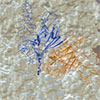| Feb 07, 2022 |
|
(Nanowerk News) University of Exeter scientists have discovered new information about the tiny propellers used by single-cell organisms called archaea.
|
|
Like bacteria, archaea are found in a vast range of habitats – including inside human bodies – but unlike bacteria they are not known to cause disease.
|
|
Some archaea propel themselves to incredible speeds by rotating a spiral-shaped filament called an archaellum.
|
|
Using a powerful cryo-electron microscope, the new study examined this closer than ever before (Nature Communications, “An archaellum filament composed of two alternating subunits”).
|
 |
| Representation of the M. villous archaellum highlighting the two alternating subunits in blue and orange (foreground) and swimming M. villosus cells (background). (Image: University of Exeter)
|
|
The research team – which included the University of Regensburg – focussed on Methanocaldococcus villosus, a species found near underwater volcanoes off Iceland, where water temperatures can reach about 80 °C.
|
|
“M. villosus swims at a speed of about 500 body lengths per second,” said Dr Lavinia Gambelli, of Exeter’s Living Systems Institute (LSI).
|
|
“Considering that the tiny cell is only about one micrometre in size, this means half a millimetre in one second.
|
|
“At first glance, this does not seem much.
|
|
“But in comparison, a cheetah achieves only 20 body lengths per second – so if an M. villosus cell had the size of a cheetah, it would swim at approximately 3,000 kilometres per hour.
|
|
“The incredible speed that M. villosus can achieve makes it one of the fastest organisms on the planet.”
|
|
Using the cryo-electron microscope, researchers can see objects whose width is as small as only a few hydrogen atoms.
|
|
“At this resolution, we can see the very fabric of life and study fundamental biological processes at atomic detail,” said Dr Bertram Daum, also of the LSI.
|
|
“In this study, we were able to look closely at the smallest propeller in the world, to find out more about its shape and how it works.
|
|
“As well as teaching us more about these fascinating organisms, this could have implications for human health and technology.
|
|
“Archaea make up a considerable percentage of the microorganisms found in the human body. None has so far been found to cause disease, but it remains a possibility.
|
|
“In the future, it might even be possible to develop microscopic robotic devices for drug delivery based on the tiny propellers used by archaea.”
|
|
The study discovered that the filament used by M. villosus is made up of thousands of copies of two alternating proteins, whereas previously investigated filaments showed only one protein.
|
|
This suggests that the architecture and assembly of an archaellum is more complex than previously thought.
|
|
The researchers also identified two major structural elements that enable the archaellum filament to move, propelling the cell at high speed.
|


